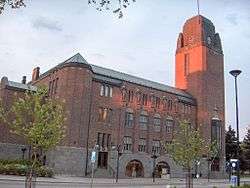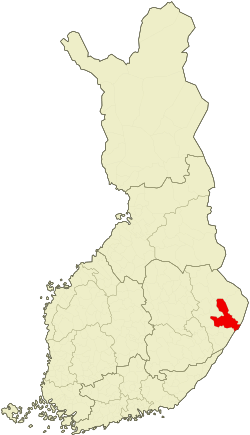Joensuu
Joensuu (Finnish pronunciation: [ˈjoensuː]; lit. "river's mouth"; Karelian: Jovensuu) is a city and municipality in North Karelia, Finland. It was founded in 1848. The population of Joensuu is 76,543 (January 31, 2019),[1] and the economic region of Joensuu has a population of 115,000.[6] The nearest major city, Kuopio in North Savonia, is located 136 kilometres (85 mi) to the west. As is typical of cities in Eastern Finland, Joensuu is monolingually Finnish.
Joensuu | |
|---|---|
City | |
| Joensuun kaupunkiJoensuu stad | |
 Joensuu City Hall | |
 Flag  Coat of arms | |
 Location of Joensuu in Finland | |
| Coordinates: 62°36′N 029°45′E | |
| Country | |
| Region | |
| Sub-region | Joensuu sub-region |
| Charter | 1848 |
| Government | |
| • City manager | Kari Karjalainen |
| Area (2018-01-01)[1] | |
| • Total | 2,751.07 km2 (1,062.19 sq mi) |
| • Land | 2,381.76 km2 (919.60 sq mi) |
| • Water | 369.31 km2 (142.59 sq mi) |
| Area rank | 26th largest in Finland |
| Population (2019-01-31)[2] | |
| • Total | 76,543 |
| • Rank | 12th largest in Finland |
| • Density | 32.14/km2 (83.2/sq mi) |
| Population by native language | |
| • Finnish | 97.4% (official) |
| • Swedish | 0.1% |
| • Others | 2.5% |
| Population by age | |
| • 0 to 14 | 15.3% |
| • 15 to 64 | 68.5% |
| • 65 or older | 16.2% |
| Time zone | UTC+02:00 (EET) |
| • Summer (DST) | UTC+03:00 (EEST) |
| Municipal tax rate[5] | 19.5% |
| Unemployment rate | 14.5% |
| Website | www.jns.fi |
Joensuu is a lively student city with a subsidiary of the University of Eastern Finland, which has over 15,000 enrolled students, and a further 4,000 students at the Karelia University of Applied Sciences.[7]
The largest employers are the municipal City of Joensuu, North Karelian Hospital District Federation of Municipalities, Abloy and Punamusta.
The European Forest Institute, the University and many other institutes and export enterprises such as Abloy and John Deere give Joensuu an international flavour.
History
The city of Joensuu, founded by the Czar Nicholas I of Russia in 1848, is the regional centre and the capital of North Karelia. During the 19th century Joensuu was a city of manufacture and commerce. When in 1860 the city received dispensation rights to initiate commerce, former restrictions against industry were removed and the local sawmills began to prosper and expand. Water traffic was improved by the building and opening of the Saimaa Canal in 1856. Consequently, a lively commerce between the regions of North Karelia, St. Petersburg and Central Europe was enabled. At the end of the 19th century Joensuu was one of the largest harbour cities in Finland.
Throughout the centuries Karelian traders have plied the Pielisjoki River. The river has always been the lively heart of the city. Canals – completed by 1870 – increased the river traffic. Thousands of steamboats, barges and logging boats sailed along the river during the golden age of river traffic. The Pielisjoki River has also been an important log raft route, providing wood for the sawmills and for the entire lumber industry.
During the last few decades, the formerly modest agrarian town has developed into a vital centre of the province. Success in regional annexations, the establishment of the province of Karelia and investments in education have been the most decisive actions in this development.
The municipality of Pielisensuu was consolidated with Joensuu in 1954. At the beginning of 2005, the municipalities of Kiihtelysvaara and Tuupovaara were consolidated with Joensuu. At the beginning of 2009 the municipalities of Eno and Pyhäselkä were consolidated with Joensuu. After the most recent consolidations, there are approximately 73,000 inhabitants in the Joensuu municipal area.

The University of Joensuu (now part of the University of Eastern Finland since January 2010.[8]) has, in twenty-five years, expanded to eight faculties. The university is one of the mainstays for the vitality of the city and so for all North Karelia. Diversified international cooperation in science, industry and commerce benefits the whole region.
The proximity of the eastern border has been an important factor in the history of the city. The Republic of Karelia is once again a significant area for cooperation with nearby regions in Russia. Export companies in Joensuu continue the pre-revolutionary traditions in foreign trade.
Joensuu offers varied cultural activities. A series of events – Ilosaarirock festival, Joensuu Music Winter, Festival of Visual Culture Viscult, Gospel festivals – and the unspoilt environment increase the attractiveness of the city.
Joensuu is sometimes referred to as the Forest Capital of Europe, mainly because the European Forest Institute is based there. Other forestry research and educational facilities are also based in Joensuu.
Education
Joensuu is a city of students.[9] The University of Eastern Finland (UEF) has one of its three main campuses in Joensuu[10] and the University of Applied Sciences Karelia[11] has two Joensuu campuses.
Statistics
- Nearest airport with regular air service: Joensuu Airport, Liperi, 11 km
- Nearest inland port: Joensuu
- Districts: 26
Transport
Distances to other cities
Distances from Joensuu to other major cities in Finland:
| City | Distance | Direction |
|---|---|---|
| Helsinki | 437 km | SW |
| Jyväskylä | 245 km | W |
| Kuopio | 136 km | NW |
| Lappeenranta | 235 km | SW |
| Oulu | 393 km | NW |
| Kajaani | 222 km | NW |
| Savonlinna | 133 km | SW |
| Tampere | 393 km | SW |
| Turku | 542 km | SW |
| Vaasa | 492 km | W |
Joensuu has a railway station and a bus station, which offers intercity connections to Helsinki and local connections to several other places. Numbered bus service is available to all parts of Joensuu (Route maps, Timetables). Note, that if you want to catch a bus, you have to wave at the driver - the bus does not stop automatically. Joensuu also has an airport, with flights to Helsinki.
Joensuu is located along the Blue Highway, which is an international tourist route from Mo i Rana, Norway to Pudozh, Russia via Sweden.
Sports
The city is known for its basketball club Kataja, which plays in the Finnish first-tier league Korisliiga. Other championship level clubs of Joensuu include Josba (floorball), Mutalan Riento (volleyball), the world leading orienteering club Kalevan Rasti (orienteering) and Joensuun Prihat (women's volleyball). The ice hockey team Jokipojat plays in the Finnish second-tier league Mestis, and their home arena is the Mehtimäki Ice Hall. The local football club Jippo plays in the Finnish second Division. Finnish baseball enjoys popularity as well and the local team, Joensuun Maila, plays in the top division Superpesis.
Notable sportspeople from Joensuu include Jukka Keskisalo, the European champion in 2006 at 3000m St., and Aki Parviainen, the world champion of Javelin throw in 1999; biathlete Kaisa Mäkäräinen, who won three overall World Cup titles in the 2010–11, 2013–14 and 2017–18 seasons; 1983 WRC champion Hannu Mikkola; 2013 GRC champion and current World RX driver Toomas Heikkinen; and NHL ice hockey players Urho Vaakanainen and Juuso Riikola.
Geography
Climate
Joensuu has a subarctic climate (Köppen: Dfc) due to its high latitude and inland position. Being quite far inland, Joensuu has a more continental climate than most of Finland. As a result, Joensuu can be prone to temperature extremes both in winter and summer. For example, Joensuu is on average warmer than Dublin or Manchester in July, and colder than Moscow in January. Winters are long, cold and snowy. Summers however, bring frequent temperatures above 20.0 °C (68.0 °F) and thunderstorms occur typically on 10–15 days per year.[12] An all-time record of 37.2 °C (99.0 °F) on July 29, 2010, is also the Finnish nationwide heat record. The coldest temperature ever recorded in Joensuu was −40.0 °C (−40.0 °F) on December 10, 1955. In winter, the snowcover is reliable and on average 50–70 cm deep. Annually, Joensuu experiences on average 24 days with temperatures −20 °C (−4 °F) or colder while temperature below −30 °C (−22 °F) is observed about once per year. Annual total precipitation averages at 589 mm, with about 225 mm of it falling in the form of snow.[13][14]
| Climate data for Joensuu (1981-2010, extremes 1955 - present). | |||||||||||||
|---|---|---|---|---|---|---|---|---|---|---|---|---|---|
| Month | Jan | Feb | Mar | Apr | May | Jun | Jul | Aug | Sep | Oct | Nov | Dec | Year |
| Record high °C (°F) | 6.7 (44.1) |
7.8 (46.0) |
12.8 (55.0) |
23.5 (74.3) |
28.7 (83.7) |
32.0 (89.6) |
37.2 (99.0) |
31.4 (88.5) |
25.8 (78.4) |
16.6 (61.9) |
10.5 (50.9) |
8.3 (46.9) |
37.2 (99.0) |
| Average high °C (°F) | −6.4 (20.5) |
−6.2 (20.8) |
−0.5 (31.1) |
6.0 (42.8) |
13.9 (57.0) |
18.8 (65.8) |
21.8 (71.2) |
18.8 (65.8) |
12.8 (55.0) |
6.0 (42.8) |
−0.5 (31.1) |
−4.3 (24.3) |
6.7 (44.1) |
| Daily mean °C (°F) | −9.6 (14.7) |
−9.7 (14.5) |
−4.4 (24.1) |
1.7 (35.1) |
8.7 (47.7) |
14.1 (57.4) |
17.1 (62.8) |
14.5 (58.1) |
9.2 (48.6) |
3.6 (38.5) |
−2.6 (27.3) |
−7.3 (18.9) |
2.9 (37.2) |
| Average low °C (°F) | −13.4 (7.9) |
−13.7 (7.3) |
−8.6 (16.5) |
−2.7 (27.1) |
3.3 (37.9) |
8.9 (48.0) |
12.3 (54.1) |
10.3 (50.5) |
5.6 (42.1) |
1.0 (33.8) |
−5.2 (22.6) |
−10.6 (12.9) |
−1.0 (30.2) |
| Record low °C (°F) | −39.0 (−38.2) |
−38.5 (−37.3) |
−32.1 (−25.8) |
−21.4 (−6.5) |
−10.5 (13.1) |
−4.2 (24.4) |
2.2 (36.0) |
−1.7 (28.9) |
−7.2 (19.0) |
−16.8 (1.8) |
−27.3 (−17.1) |
−40.0 (−40.0) |
−40.0 (−40.0) |
| Average precipitation mm (inches) | 42 (1.7) |
33 (1.3) |
31 (1.2) |
28 (1.1) |
41 (1.6) |
64 (2.5) |
65 (2.6) |
80 (3.1) |
53 (2.1) |
54 (2.1) |
50 (2.0) |
48 (1.9) |
589 (23.2) |
| Average precipitation days (≥ 0.1 mm) | 20 | 17 | 15 | 11 | 12 | 14 | 14 | 16 | 15 | 17 | 20 | 21 | 192 |
| Source: FMI (Temperature data for Liperi Airport elevation 121 m, precipitation Joensuu Pyhäselkä elevation 79 m)[15] | |||||||||||||
Friendship cities
Joensuu is twinned with:[16]
See also
- Öllölä
- Sini Manninen, painter born in the city
References
- "Area of Finnish Municipalities 1.1.2018" (PDF). National Land Survey of Finland. Retrieved 30 January 2018.
- "Suomen virallinen tilasto (SVT): Väestön ennakkotilasto [verkkojulkaisu]. Tammikuu 2019" (in Finnish). Statistics Finland. Retrieved 15 March 2019.
- "Population according to language and the number of foreigners and land area km2 by area as of 31 December 2008". Statistics Finland's PX-Web databases. Statistics Finland. Retrieved 29 March 2009.
- "Population according to age and gender by area as of 31 December 2008". Statistics Finland's PX-Web databases. Statistics Finland. Retrieved 28 April 2009.
- "List of municipal and parish tax rates in 2011". Tax Administration of Finland. 29 November 2010. Retrieved 13 March 2011.
- "City of Joensuu" (PDF). Welcoming Guide. North Karelia University of Applied Sciences. Retrieved 12 February 2013.
- "Archived copy". Archived from the original on 2010-04-17. Retrieved 2010-01-15.CS1 maint: archived copy as title (link)
- Steps leading to the establishment of the UEF Archived 2013-02-27 at the Wayback Machine
- "Education - joensuu.fi". www.joensuu.fi (in Finnish). Retrieved 2017-09-13.
- "Introduction | UEF". www.uef.fi. Retrieved 2017-09-13.
- "Introduction | KAUS". www.karelia.fi/en/. Retrieved 2017-10-03.
- "FMI open data". FMI. Retrieved 10 May 2019.
- "Kansainvälinen Joensuu" (in Finnish). City of Joensuu. Retrieved 21 August 2019.
External links
![]()
- Joensuu Marketplace webcam
- City of Joensuu (in English)
- City of Joensuu (in Finnish)
- Pielis.ru – Travel information about North Karelia region and City of Joensuu
